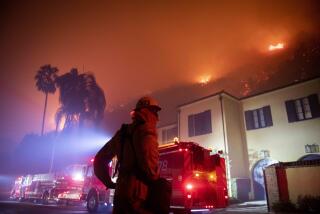Bank’s Big Depositors Hit by Limit on FDIC Coverage : Money: Some patrons of the Bank of Beverly Hills, now in the hands of regulators, stand to lose deposits in excess of $100,000.
- Share via
Last Friday afternoon, state banking authorities shut the ailing Bank of Beverly Hills and issued their standard statement designed to ease customer anxiety: “All deposits are insured up to $100,000 per account. “
Not so, says the Federal Deposit Insurance Corp., the agency that covers bank deposits. Technically speaking, all depositors at a bank are covered up to $100,000 by the agency, but not necessarily all accounts. In hindsight, state officials say, the FDIC is right.
The news has been painful for some customers of the bank, reflecting a growing trend in which businesses and well-heeled depositors have been put at greater risk of losing money because of recent policy changes regarding deposit insurance.
Mike Bohlke, a Los Angeles businessman who buys and fixes up apartment buildings, said he and his wife stand to lose as much as $40,000 above the $100,000 they had that is insured at that bank because they had their funds in two separate accounts. If he does lose that much money, Bohlke said, “I’ll have to look for a new source of funds.”
Likewise, lawyer John Weston says his law firm stands to lose somewhere in the “six figures” in checking and other accounts that he too thought were covered by insurance. Bohlke and Weston are among those Bank of Beverly Hills customers who altogether have accounts with $6 million in deposits that the government says aren’t covered by federal deposit insurance.
FDIC spokesman David Barr said it is a common misconception among the public that every individual account is insured up to $100,000. He said the basic policy of insuring depositors at a bank up to $100,000 has been in place for years, although it is now being applied more often as a result of the policy changes.
Barr says that individuals with multiple certificates of deposit at the bank, for example, won’t enjoy more than $100,000 worth of insurance protection. The only exception, he notes, is for those customers who use a couple of exceptions in the federal deposit insurance rules. Those exceptions extend additional protection, for example, to those holding joint accounts with another person such as a spouse, a business account or those who have Individual Retirement Accounts with a bank.
The Bank of Beverly Hills case reflects the kind of anxiety common these days among large depositors over how much is and isn’t covered under a deposit insurance system many find confusing and inconsistent.
Few depositors ever lose money when an institution closes because most people have accounts with far less than $100,000 in them. In addition, the government in many past cases informally protected uninsured deposits by transferring all of a failed institution’s deposits to a new buyer. Such was the case last year when the large Bank of New England failed and was sold to a group headed by Fleet/Norstar, a Rhode Island bank.
But new policy changes now require the FDIC to transfer just the insured deposits to a new buyer because the end result is cheaper to the government’s deposit insurance pool. In the case of the Bank of Beverly Hills, FDIC spokesman Barr said, one bid was received and rejected.
On average, less than one out of five bank failures used to result in customers with large amounts of money on deposit losing the portion that wasn’t covered by insurance. Now, about half of the failures result in some wealthier depositors losing some money that is uninsured.
The Bank of Beverly Hills had an unusually large proportion of uninsured deposits, with some 5% of its $115.2 million in deposits exceeding the federal insurance limit. Part of the uninsured funds may be recovered later for depositors after the FDIC liquidates the bank and shares some of the proceeds with them.
That prospect is bringing little comfort to Bohlke and lawyer Weston. Both say they were surprised that regulators swooped down last week and closed the bank, which suffered from high overhead and big losses on real estate and commercial loans. Bank regulators say it is the responsibility of the bank’s executives to report and make available to customers information on the institution’s most recent financial condition.
Weston also complained that the government recently covered some $20 million in uninsured deposits at a high-profile failure, Independence Bank in Encino, which was secretly owned for years by the scandal-plagued Bank of Credit and Commerce International.
But the FDIC’s Barr said that the Independence deposits are being covered in that case only because of money the government received as part of a record criminal settlement in the BCCI case.
More to Read
Sign up for Essential California
The most important California stories and recommendations in your inbox every morning.
You may occasionally receive promotional content from the Los Angeles Times.













